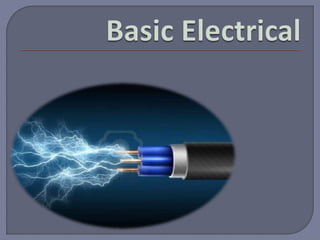
Basic electrical
- 2. The entire study of electricity is based on the Electron Theory This assumes that all electrical and electronic effects are due to the movements of electrons from one place to another Before we work with electricity we must know what an electron is and what causes it to move
- 3. Atom is the smallest particle of a chemical element that can exist. The atom is the building block of all stuff, or what scientists call "matter". Atoms are composed of particles called protons, electrons and neutrons Electron has negative charge. Proton has positive charge. Neutron has negative charge.
- 4. An electric current is a flow of electric charge. In electric circuits this charge is often carried by moving electrons in a wire . Current is usually denoted by the symbol I. A common unit of electric current is the ampere.
- 5. Voltage, also called electromotive force, is a quantitative expression of the potential difference in charge between two points in an electrical field. For electricity to flow, there has to be something to push the electrons along. This is called an electromotive force (EMF) A battery or power outlet creates this Electromotive force which induces current in a circuit. EMF is measured in volts and denoted by V. The difference in EMF across two points is called the potential difference (VOLTAGE). (change in electrical potential energy)
- 6. Resistance is a material’s tendency to resist the flow of charge (current). The electrical resistance of an electrical conductor is a measure of the difficulty to pass an electric current through that conductor. The resistance is measured in units of ohms (Ω) and denoted by R.
- 8. Conductors are generally substances which have the property to pass different types of energy. In the following, the conductivity of electricity is the value of interest. Metals The conductivity of metals is based on the free electrons (so-called Fermi gas) due to the metal bonding. Already with low energy electrons become sufficiently detached from the atoms and a conductivity is achieved. Salts In addition to metals, salts can also conduct electricity. There are no free electrons, so the conductivity depends on ions which can be solved when a salt is melting or dissolving, so that the ions are free to move.
- 9. Insulators possess no free charge carriers and thus are non- conductive. Some common insulators are PVC, glass, , wood , paper, Teflon, rubber, mica, ceramic etc.
- 10. There are two different types of current in widespread use today. (A) Alternating Current-AC (B) Direct Current – DC Alternating current pushes the electrons back and forth, changing the direction of the flow several times per second. In the India, the current changes direction at a rate of 50 hertz, or 50 times in one second. The generators used in power plants to produce electricity for your home are designed to produce alternating current. You've probably never noticed the lights in your house actually flicker as the current changes direction because it happens too fast for our eyes to detect..
- 11. In a Direct Current, the electrons flow in one direction i.e. Direct current (DC) is the unidirectional flow of electric charge. Batteries create a direct current because the electrons always flow from the 'negative' side to the 'positive' side. Sources of DC- Solar panel, Dynamo, Battery etc.
- 12. Direct current may be obtained from an alternating current supply by use of a rectifier, which contains electronic elements that allow current to flow only in one direction. Direct current may be converted into alternating current with an inverter or a motor-generator set.
- 13. In an electrical installation an earthing system or grounding system connects specific parts of that installation with the Earth's conductive surface for safety and functional purposes. The point of reference is the Earth's conductive surface. The choice of earthing system can affect the safety and electromagnetic compatibility of the installation. An earth ground connection of the exposed conductive parts of electrical equipment helps protect from electric shock by keeping the exposed conductive surface of connected devices close to earth potential, when a failure of electrical insulation occurs. When a fault occurs, current flows from the power system to earth.
- 17. A sensor is a device, module, or subsystem whose purpose is to detect events or changes in its environment and send the information to other electronics, frequently a computer processor. A sensor is always used with other electronics, whether as simple as a light or as complex as a computer. A good sensor obeys the following rules: it is sensitive to the measured property it is insensitive to any other property likely to be encountered in its application, and it does not influence the measured property Types of sensor:- Some common names of sensors are given below. Temperature Sensor. Proximity Sensor. Accelerometer. IR Sensor (Infrared Sensor) Pressure Sensor. Light Sensor. Ultrasonic Sensor. Smoke, Gas and Alcohol Sensor.
- 19. A proximity sensor is a sensor able to detect the presence of nearby objects without any physical contact. A proximity sensor often emits an electromagnetic field or a beam of electromagnetic radiation (infrared, for instance), and looks for changes in the field or return signal. The object being sensed is often referred to as the proximity sensor's target. Different proximity sensor targets demand different sensors. For example, a capacitive proximity sensor or photoelectric sensor might be suitable for a plastic target; an inductive proximity sensor always requires a metal target. The maximum distance that this sensor can detect is defined "nominal range". Some sensors have adjustments of the nominal range or means to report a graduated detection distance.
- 20. Parking sensorss, systems mounted on car bumpers that sense distance to nearby cars for parking Ground proximity warning system for aviation safety Vibration measurements of rotating shafts in machinery Top dead centre (TDC)/camshaft sensor in reciprocating engines. Sheet break sensing in paper machine. Anti-aircraft warfare Roller coasters
